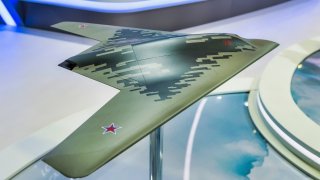Russia's Sukhoi S-70 Okhotnik-B Drone Could Dominate—If It Ever Reaches the Battlefield
Often referred to as Hunter-B, when this stealth-heavy unmanned combat aerial vehicle does enter service, NATO will surely have to take note.
Summary: Russia's development of the Sukhoi S-70, also known as Hunter-B, signals a significant leap towards integrating advanced stealth and combat capabilities into its drone arsenal. Designed in collaboration between Sukhoi and MiG, the S-70 promises to be a formidable presence on the battlefield, potentially altering the dynamics of aerial combat with its stealth features, impressive speed, and long-range capabilities. Despite these advancements, the drone's deployment faces challenges, notably due to international sanctions that have impacted Russia's ability to procure crucial components, raising questions about the feasibility and timing of the S-70 reaching operational status.
The S-70 Hunter-B: Russia's Answer to Next-Generation Drone Warfare
Drone warfare has taken center stage in Russia’s invasion of Ukraine. Both sides in the conflict use a wide range of domestic and imported unmanned aerial vehicles (UAVs) to pursue their war efforts.
Moscow relies on homegrown drones supplemented by Iran-designed counterparts, while Kyiv uses its own UAVs alongside weapons imported from the West.
The Kremlin has long claimed that when it arrives, Russia’s Sukhoi S-70 drone will dominate on the battlefield. Often referred to as Hunter-B, when this stealth-heavy unmanned combat aerial vehicle does enter service, NATO will surely have to take note.
The History of the S-70
According to Russian state-run media sources, the Ohotnik S-70 drone has been under development for roughly fifteen years.
In 2011, manufacturer Sukhoi was selected by Russia’s Defense Ministry to design and create a new unmanned reconnaissance and attack drone for its armed forces. Currently, the upcoming UAV is being created by Sukhoi and MiG collaboratively at the Novosibirsk Aircraft Production Association. The manufacturers debuted the S-70 in 2017, showcasing the weapon’s flying wing configuration. Within a few years, the drone successfully carried out its maiden flight and flew above the Chkalov State Flight Test Center in Akhtubinsk at an altitude of 600 meters.
In 2019, a Su-57 prototype was spotted flying alongside an S-70. According to Russian officials, the Su-57 is being used to test the S-70’s avionics systems. Russia’s Ministry of Defense published footage depicting the Hunter-B drone flying next to a Su-57 to test the jet’s radar and its ability to use long-range air-launched weapons.
Specs and Capabilities
The Hunter-B drone weighs approximately 20 tons and is powered by the same AL-31 turbojet engine that is used by the Sukhoi Su-27 fighter jet. With this engine, the UAV can reach speeds greater than 620 miles per hour, with a range of nearly 3,730 miles. Some Russian outlets suggest that the S-70 could deploy the Kh-59 Mk2 standoff cruise missile, which is estimated to be capable of reaching targets at least 150 miles away. Part of the Kh-59 series of heavy tactical missiles, this variant can carry a 500-pound warhead.
The new drone is expected to fly alongside the Su-57 stealth fighter in a wingman role, similar to plans for the U.S. Air Force’s upcoming Next Generation Air Dominance program. Andrey Yelchaninov, first deputy chairman of the board of Moscow’s Russian-Military Industrial Commission, described the plan:
“These planes and drones can interact not only with each other but also in various types of combat formations.” He added that “within a very short timeframe, there will be a possibility to control several Okhotnik drones from the Su-57 cockpit.”
Will the S-70 Be Deployed Anytime Soon?
Russian defense contractor Rostec examined the artificial intelligence datalink that enables the loyal wingman connection between the S-70 and the Su-57:
“AI-based technology enables noise-immune coding through the use of parallel channels. This is the ‘wrap’ of the technology. Its structure includes multiple interleaving of symbols, time synchronization during transfer, simultaneous transmission of data in all directions [air-to-ground or air-to-air], and increasing the range of transmitted data.”
Since Russia first invaded Ukraine more than two years ago, the international community has imposed heavy sanctions on the Kremlin, crippling its defense output capabilities. In fact, Russia has so greatly struggled to acquire computer chips and other components necessary to sustain its military equipment that it has resorted to repurposing microchips from dishwashers and refrigerators.
Moscow’s ability to produce the S-70 drones on schedule hinges on how it confronts its manufacturing limitations. Russia could resort to alternate means of acquiring the materials needed to get the Hunter-B drone to the frontlines. For example, Russian officials have depended on their Iranian counterparts to fulfill Moscow’s drone needs over the last two years. Tehran could contribute to Moscow’s production efforts regarding the S-70 drone as well.
Russia has a tendency to exaggerate its military equipment’s capabilities, so the relative sophistication of the S-70 may be overblown. Considering Moscow’s lack of progress in the Russia-Ukraine war, the imminent deployment of the Hunter-B drone seems unlikely.

About the Author: Maya Carlin
Maya Carlin, National Security Writer with The National Interest, is an analyst with the Center for Security Policy and a former Anna Sobol Levy Fellow at IDC Herzliya in Israel. She has by-lines in many publications, including The National Interest, Jerusalem Post, and Times of Israel. You can follow her on Twitter: @MayaCarlin.


